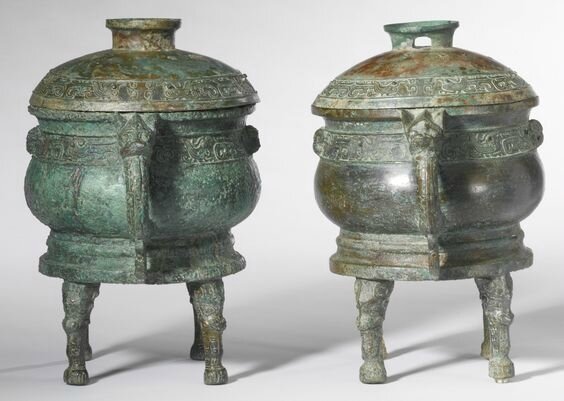The Lu Hou Gui. An important pair of bronze ritual food vessels, Middle Western Zhou dynasty, 10th-9th century BC
Lot 108. The Lu Hou Gui. An important pair of bronze ritual food vessels, Middle Western Zhou dynasty, 10th-9th century BC. Height 10 3/4 in., 27 cm; 10 1/4 in., 26 cm. Estimate 180,000 — 280,000 USD. Lot sold 1,025,000 USD. Photo: Sotheby's 2017.
each standing on four paw feet issuing from animal masks cast in relief underneath the short foot ring, the contracted neck with a band of eight phoenixes with protruding eyes, beaks, curled crests and elongated tails between two bowstring bands, centered on two sides by animal masks in relief and flanked by two loop handles with hooked pendent extensions springing from animal masks, the cover decorated with a band of four pairs of confronting phoenix, each centered by a stylized bovine mask below the flared knop, the foot encircled by a wide bow string band, the brown patina with malachite encrustation, both vessels with a seven-character inscription reading lu hou zuo xiang bao zun yi, one cover with a six-character inscription, reading lu hou zuo bao zun yi (4).
Provenance: Acquired from an old Asian collection, by repute.
Exhibited: Yale University Art Gallery, New Haven, 2010-2012.
Note: Gui vessels with four legs are a rare and special type of ritual food vessel and were produced only for a short period of time. Early experiments in raising gui vessels on four cylindrical legs can be observed on the Chen Chen gui, now in the Harvard Fogg Museum and illustrated in Chen Mengjia, In Shu seidoki bunrui zuroku (A Corpus of Chinese Bronzes in American Collection), no. A230. The Chen Chen gui belongs to the famous Chen Chen group of bronze vessels unearthed from Luoyang in 1920s and dates from the reign of King Zhao. Another famous example is the Ban gui, whose four legs were cast in the form of elephant trunks, dating from the reign of the King Mu and illustrated in Jessica Rawson, Western Zhou Ritual Bronzes from the Arthur M. Sackler Collections, Washington D.C., 1990, vol. IIB, p. 470. The legs on both the Chen Chen gui and Ban gui are all placed underneath the four loop handles. However, the majority of gui only have two handles and a four-leg version of those vessels entails at least two legs being placed on the ring foot. See Yi Gong gui with two legs underneath the handles and two legs on the ring foot, excavated near Beijing and illustrated in Jessica Rawson, Western Zhou Ritual Bronzes from the Arthur M. Sackler Collections, Washington D.C., 1990, vol. IIB, pp. 469. On the Zi gui, now in the National Museum of China and illustrated in Jessica Rawson, Western Zhou Ritual Bronzes from the Arthur M. Sackler Collections, Washington D.C., 1990, vol. IIB, pp. 470, all four legs have been moved to the ring foot. The present pair not only has their elaborate legs cast on the ring foot but also positioned four legs in parallel to the handles. This feature and the elongated phoenix motif indicate that the dating of the present pair is later than the aforementioned examples, probably in the late 10th century BC.
The inscriptions on both vessels can be translated as 'the Marquis of Lu made this precious vessel.' Founded by the eldest son of the Duke of Zhou, Lu was one of the most important vassal states in the Zhou dynasty. Moreover, the Duke of Zhou was the founding father of the Zhou culture and rites, most of which were preserved in Lu after the fall of the Western Zhou dynasty. This enabled Lu to exert influence over other states. In the following Eastern Zhou dynasty, it produced the first chronicle in Chinese history: Annals of Spring and Autumn and bred China’s greatest philosopher Confucius. Although Lu played a prominent role in Chinese history, bronze vessels cast by Lu ruling elites are very rare. Only five other Western Zhou bronzes bearing the name of the Marquis of Lu are recorded, including the cover of a he from the Lushun Museum, published in Wu Zhenfeng, Shangzhou qingtongqi mingwen ji tuxiang jicheng, (Compendium of Inscriptions and Images of Bronzes from the Shang and Zhou Dynasties), Shanghai, 2012, vol. 26, p. 134, no. 14724; one jue vessel in the Palace Museum, illustrated in Bronzes in the Palace Museum, Beijing, 1999, p. 143, no. 125; one gui vessel in the Shanghai Museum, discussed and illustrated in Chen Peifen, Xiashangzhou qingtongqi yanjiu (Research on Bronzes from the Xia Shang and Zhou Dynasties), Shanghai, 2004, vol. 4, pp. 136-137; one li vessel in the Museum of Fine Arts, Boston illustrated in Chen Mengjia, In Shu seidoki bunrui zuroku (A Corpus of Chinese Bronzes in American Collections), no. A123; and another li vessel in the Sackler collection discussed and illustrated in Jessica Rawson, Western Zhou Ritual Bronzes from the Arthur M. Sackler Collections, Washington D.C., 1990, vol. IIB, pp. 328-329. Among these known examples, four are from the early Western Zhou dynasty and one is from the late Western Zhou. The present pair seems to be the only example of the middle Western Zhou Lu bronzes. According to the famous scholar in bronzes, Zhu Fenghan, “other than a few handed-down pieces, most of excavated Lu bronzes are from the Eastern Zhou. If we want to understand the bronze culture of Lu and explore the history of Lu in the Western Zhou dynasty, there is still a lot of work to be done.” The appearance of this pair of gui therefore contributes substantially to the study of Lu bronzes.

/https%3A%2F%2Fprofilepics.canalblog.com%2Fprofilepics%2F1%2F0%2F100183.jpg)
/https%3A%2F%2Fstorage.canalblog.com%2F03%2F02%2F119589%2F96711876_o.jpg)
/https%3A%2F%2Fstorage.canalblog.com%2F11%2F31%2F119589%2F94773502_o.jpg)
/https%3A%2F%2Fstorage.canalblog.com%2F20%2F83%2F119589%2F94772815_o.jpg)
/https%3A%2F%2Fstorage.canalblog.com%2F26%2F72%2F119589%2F75604929_o.jpg)
/https%3A%2F%2Fstorage.canalblog.com%2F59%2F60%2F119589%2F26458628_o.jpg)








/image%2F1371349%2F20240406%2Fob_b23648_434058570-1644317966338216-88086167391.jpg)
/image%2F1371349%2F20240403%2Fob_6d5ae7_dp-28103-001.jpg)
/image%2F1371349%2F20240229%2Fob_8f31f9_431013694-1625286614908018-33034430839.jpg)
/http%3A%2F%2Fstorage.canalblog.com%2F79%2F20%2F119589%2F129837997_o.jpg)